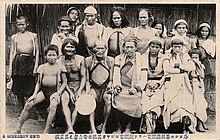 The families of the outer Truku chief-general and deputy chief-general The families of the outer Truku chief-general and deputy chief-general | |
| Total population | |
|---|---|
| 32,333 (January 2020) | |
| Regions with significant populations | |
| Taiwan | |
| Languages | |
| Truku, Mandarin | |
| Religion | |
| Animism, Christianity | |
| Related ethnic groups | |
| Other Taiwanese Aborigines Especially Atayals and Seediq |
The Taroko people (Chinese: 太魯閣族; pinyin: Tàilǔgézú), also known as Truku people, are an Indigenous Taiwanese people. Taroko is also the name of the area of Taiwan where the Taroko reside. The Executive Yuan, Republic of China has officially recognized the Taroko since 15 January 2004. The Taroko are the 12th aboriginal group in Taiwan to receive this recognition.
Previously, the Taroko and the related Seediq people were classified in the Atayal group. The Taroko people demanded a separate status for themselves in a "name rectification" campaign.
The Taroko resisted and fought the Japanese in the 1914 Truku War.
Notable people
- Bokeh Kosang, actor and singer
- Chen Tao-ming, politician
- Lin Yueh-han, footballer
- Tseng Shu-chin, singer
Clothing
| This section does not cite any sources. Please help improve this section by adding citations to reliable sources. Unsourced material may be challenged and removed. (December 2024) (Learn how and when to remove this message) |
The traditional attire of the Truku people is predominantly fashioned from linen, with wool and cotton also being viable materials. The intricate process of crafting garments, accessories, or bedding involves several stages, including spinning, bleaching, and warping. Subsequently, the tribe's women skillfully weave flax in diverse colors, primarily encompassing shades of green, yellow, red, black, and white as a foundational palette.
Typically, men's attire consists of a sleeveless square jacket featuring a breast pocket. This square garment system incorporates long strips sewn into white ramie cloth. Two straps are affixed to both ends of the upper edge of the breast pocket, alongside two others on each side, facilitating fastening behind the neck and back. Chiefs and warriors distinguish themselves with shell clothes adorned with cylindrical shell ornaments.
Women's common attire comprises a black headdress embellished with colorful diamond shapes, a vivid blue top, and a black skirt, secured with two strips around the breast and waist. Additionally, women have two black leggings on their calves and ankles.
While variations in technique, style and texture exist across regions, the Truku people universally incorporate geometric lines and rhombus patterns as shared symbols aligned with their beliefs. Horizontal lines symbolize the path leading to the spiritual bridge, while the diamond pattern represents the ancestral spirit's vigilant eye, signifying protection.
See also
References
- "Truku Introduction". Council of Indigenous Peoples. 2 July 2020. Retrieved 2021-06-09.
- "Truku". Digital Museum of Taiwan Indigenous People. Archived from the original on 2014-12-04.
4. Official Government website specialize
| Taiwanese indigenous peoples | |
|---|---|
| Nationally recognized | |
| Locally recognized | |
| Unrecognized | |
| Ethnic groups of Taiwan | |||||||||||
|---|---|---|---|---|---|---|---|---|---|---|---|
| Han Chinese | |||||||||||
| Ethnic minorities |
| ||||||||||
| Immigrants and expatriates |
| ||||||||||
This article about an ethnic group in Taiwan is a stub. You can help Misplaced Pages by expanding it. |
- "Kanakanavu people". Council Government Website.